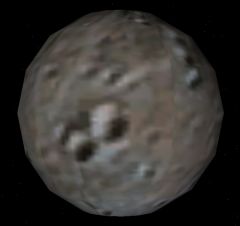3753 Cruithne
|
Project home: Cruinthe Asteroid 3753 |
3753 Cruithne is an asteroid, belonging to the w:Aten asteroid group, in an elliptical solar orbit with almost a 1:1 resonance with the Earth, and was discovered on 10 October 1986 by w:Duncan Waldron. It's orbit takes Cruithne from the orbit of Mercury to beyond that of Mars. In Orbiter, Cruithne was added as an Add-on by Burnrate in 2009.
Cruithne orbits in a 'bean-shaped' orbit when viewed from Earth's perspective. Currently, it's orbit is just slightly less than that of Earth. It orbits the Sun in about one day less than a year. It is currently orbiting ahead of Earth, and over time, it will gain a greater lead until eventually it will be opposite Earth, then will slowly catch up to Earth. As it approaches, perturbations by Earth will increase its period slightly, then it will fall behind until it reaches opposite, then approaches Earth from ahead of it, then perturbations will then decrease its period until its faster than Earth. This cycle takes about 770 years to complete. It never approaches closer to Earth than 12 million km. It's inclination is 19.8°, and its orbit never crosses that of Earth except when perturbed into its new orbit, so there is no danger of collision.
Note about the name[edit]
The add-on file is Cruinthe.zip, spelled incorrectly. this should be corrected thusly:
- Rename the file Cruinthe.cfg as 3753 Cruithne.cfg
- Open the file Cruithne.cfg, change the Name = to 3753 Cruithne and in the first line, change the spelling.
- Rename the file Read Me (Cruinthe).txt in the Doc directory to Read Me (3753 Cruithne).txt
- Open that file and change both references in there.
- Rename the files Cruinthe.tex and CruintheM.bmp as 3753 Cruithne.tex and 3753 Cruithne
Physical Characteristics in Orbiter[edit]
3753 Cruithne has a diameter of about 3300 meters, and a mass of 4.05×1013 kg. The surface gravity is only about .001 m/s2 and escape velocity is about 1.8 m/s, so, one may be able to jump beyond escape velocity. When landing a spacecraft, it may touch down slightly above or below the surface, and it may be difficult to keep your vessel in a landed state.
Orbital Characteristics in Orbiter[edit]
3753 Cruithne revolves around the Sun at a semi-major axis of just under 1 AU, almost the same distance as the Earth, with an eccentricity of a bit over 0.5, resulting in an orbit that ranges from just outside that of Mercury out past that of Mars.
Orbiting the Sun in slightly under a year, the actual 3753 Cruithne is in lockstep with Earth, approaching within about 12 million km, then drifting to the opposite side of the Sun from the Earth, to about the same distance on the other side of the Earth. It's unknown whether this phenomena is modeled in Orbiter.
It is unknown whether Orbiter can duplicate the resonance cycle.
Rotational characteristics[edit]
3753 Cruithne rotates upon its axis in 98784 seconds, or 27h 26m 34s.
Local gravity near Cruithne[edit]
When landed Cruithne provides only about 15% of the total gravity field, the Sun providing the other 85%. Acceleration due to gravity is about 0.008 m/s2, Cruithne's gravity has a reach of about 9280 km from the body.
Notice to pilots[edit]
Due to its size and mass, and the distance from the Sun, at the surface of Cruithne, the Sun's gravity is stronger than that of Cruithne, OrbitMFD shows Cruithne gravity at 0.15 and the Sun's at 0.85, so you may touchdown and stay on the surface, albeit barely, but as often you will begin to drift off the surface. Perhaps the best landing is on the night side as Cruithne and the Sun are pulling in the same direction.
The local lighting is interesting on Cruithne, the docking and landing light on the DeltaGlider will light up another ship parked nearby, but the terrain does not reflect local lights. Cruithne is opaque to the star field, the Sun and other bodies, but, if another ship is parked over the horizon, it is visible to your ship right through the terrain.
See also[edit]
- 3753 Cruithne at Wikipedia.
Gallery[edit]
3753 Cruithne as imaged by the Powell Observatory in July 2001






